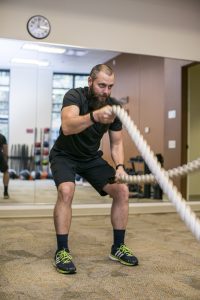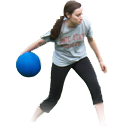
Is Your Workout Too Hard or Not Hard Enough? Here’s How to Tell
At one extreme of the workout spectrum you have people who tackle their workout at full-intensity every time but wind up fizzling out from exhaustion before the end. At the other end there are exercisers who go through their workouts at half speed, leaving too much untapped potential on the table.
Either scenario can easily be avoided by paying closer attention to how you’re handling the intensity of your workout in the moment. By noting your response, you can then decide whether you need to dial back the intensity or kick it into high gear.
That said, knowing when and how to vary intensity will revolve around your goals, says Rondel King, CSCS, exercise physiologist at NYU Langone’s Sports Performance Center.
For example, if you’re trying to improve your cardiovascular endurance, you have to find an intensity level that you can sustain for longer periods of time. On the other hand, if your goal is to boost anaerobic fitness (for activities like plyometrics or sprinting) or you need to squeeze in a quick workout but still want to maximize your caloric burn, you’ll want to work at near-maximum intensity.
Try one of the following methods during your next workout to determine whether you need to push harder or ease off.
1. The “Talk Test”
One of the easiest ways to gauge your intensity is to see if you can strike up a conversation. This method is known as the “talk test,” and, according to sports physiologist Mike Bracko, CSCS, it’s ideal for cardio and high-intensity sessions.
During a steady-state run or bike ride you should be able to chat with your workout buddy a sentence or two at a time. You want to move at a pace that’s moderate enough to allow you to go for the full 30-plus minutes. If you can only manage two or three words at a time, slow your pace until the conversation flows more easily.
On the other hand, if you’re doing high-intensity interval training (HIIT) — when you should be near your max effort during work intervals — you shouldn’t be able to say more than one or two words at a time (if any at all). “If I can have a conversation with you and you’re not taking a break to gasp for air, that probably means that you’re not at the appropriate intensity,” King says.
2. Heart Rate
Unlike the talk test, tracking your intensity via heart rate will take a bit of math and/or equipment, but the benefit of using this method is that it offers concrete, objective information that’s specific to your abilities and fitness level.
Not to mention, the numbers make it easy to determine whether you need to slow down or speed up: “If your heart rate is too high, decrease intensity,” Bracko says. By extension, if your heart rate is too low, it’s time to boost your effort level.
Again, this method will be most helpful during cardio and HIIT workouts, although one downside is that it can take some time for your technology to catch up to your heart rate, especially if you’re constantly switching up your intensity. However, heart rate monitors can give you valuable information, King says, so don’t let that deter you from using them.
Before you use a heart rate monitor, you need to calculate your maximum heart rate. There are many ways to do this, but the easiest method is to subtract your age from 220. Then you just multiply that number by whichever intensity you’re aiming for (see below) to determine what your heart rate should be.
- Low intensity: Between 50 and 60 percent of your maximum heart rate
- Moderate intensity: Between 60 and 75 percent of your maximum heart rate
- High intensity: Between 75 and 100 percent of your maximum heart rate
Here’s an example: A 35-year-old man will likely have a maximum heart rate of 185 beats per minute (bpm). This means his heart rate during a low-intensity exercise session (restorative yoga or an easy walk) will range between 96 and 116 bpm. During a moderate-intensity workout (steady-state run or bike ride) his heart rate should hover between 116 and 139 bpm. And during a high-intensity workout, his heart rate should range between 139 and 185 bpm.
3. Rating of Perceived Exertion (RPE)
Another way to gauge exercise intensity is to use the rating of perceived exertion (RPE) scale. Essentially, you rate how hard you feel like you’re working during exercise and adjust your intensity accordingly.
There are a couple of different scales you can use to rate your exertion level. The most common one is known as the Borg scale, which ranges from six to 20. Six corresponds to “no exertion at all,” while 20 means you’re working at “maximal exertion,” according to the Centers for Disease Control and Prevention. And, supposedly, if you multiply each rating by 10, that number will match your heart rate at that intensity.
For example, if you feel like you’re working at a 15 (“hard”), multiplying this number by 10 will reveal that your heart rate will likely be 150 at this level. However, Bracko warns that this measurement isn’t very accurate.
After all, heart rate will vary from person to person. You’re probably better off paying attention to how you feel instead of trying to match your exertion to a heart rate measurement.
The “one to 10” scale is similar to the Borg scale, though you may find it more intuitive to use. With this scale, one corresponds to doing nothing, while 10 means you’re giving 100 percent effort. A moderate-intensity workout should be between five and seven, and anything high-intensity will feel like a seven or above.
Check in with yourself at various points throughout your workout to make sure you’re staying at your target intensity level. Though subjective, the RPE scale can be surprisingly accurate: “If you feel like you’re exercising too hard, you probably are,” Bracko says. Similarly, if you feel like you’re not working hard enough, chances are you need to boost your intensity.
On the other hand, if you’re newer to exercise, you may not have a good handle on how your body reacts to different intensities just yet, but you’ll likely find that, as with most other things, it gets easier with time and experience.
Article by: Lauren Bedosky
The Arena District Athletic Club is more than just a gym, it’s a premier fitness facility located in the heart of the Arena District in downtown Columbus. We provide convenience and quality, featuring top-of-the-line equipment, top-notch personal trainers, spa-like locker rooms and a wide variety of free group fitness classes daily including Cardio, Spinning, Barre Fusion, Yoga, Boot Camp and more. We offer free 2-hour parking and convenient contract-free memberships, to fit your healthy lifestyle needs. Don’t just join, belong.





